The engineering and functional characterization of the Fc domain are key to therapeutic antibodies’ efficacy, safety, and pharmacokinetics.
The Fc domain is responsible for mediating interactions with Fc receptors (FcRs), which are important for modulating the antibody's half-life and triggering immune effector functions, such as antibody-dependent cellular cytotoxicity (ADCC) and phagocytosis (ADCP).
It is possible to classify FcRs into several types, each of which plays a distinct role in immune responses. These types include inhibitory receptors (e.g., FcγRIIb) and activating receptors (e.g., FcγRI, FcγRIII).
A systematic Fc functional assessment strategy allows researchers to optimize antibody effector functions, enhance pharmacokinetic stability, mitigate adverse effects, and identify potential safety risks as early as possible.
Therapeutic antibody development typically involves half-life evaluation and in vitro functional validation. These essential assessment steps are decisive in optimizing antibody candidates and successfully translating these for clinical use.
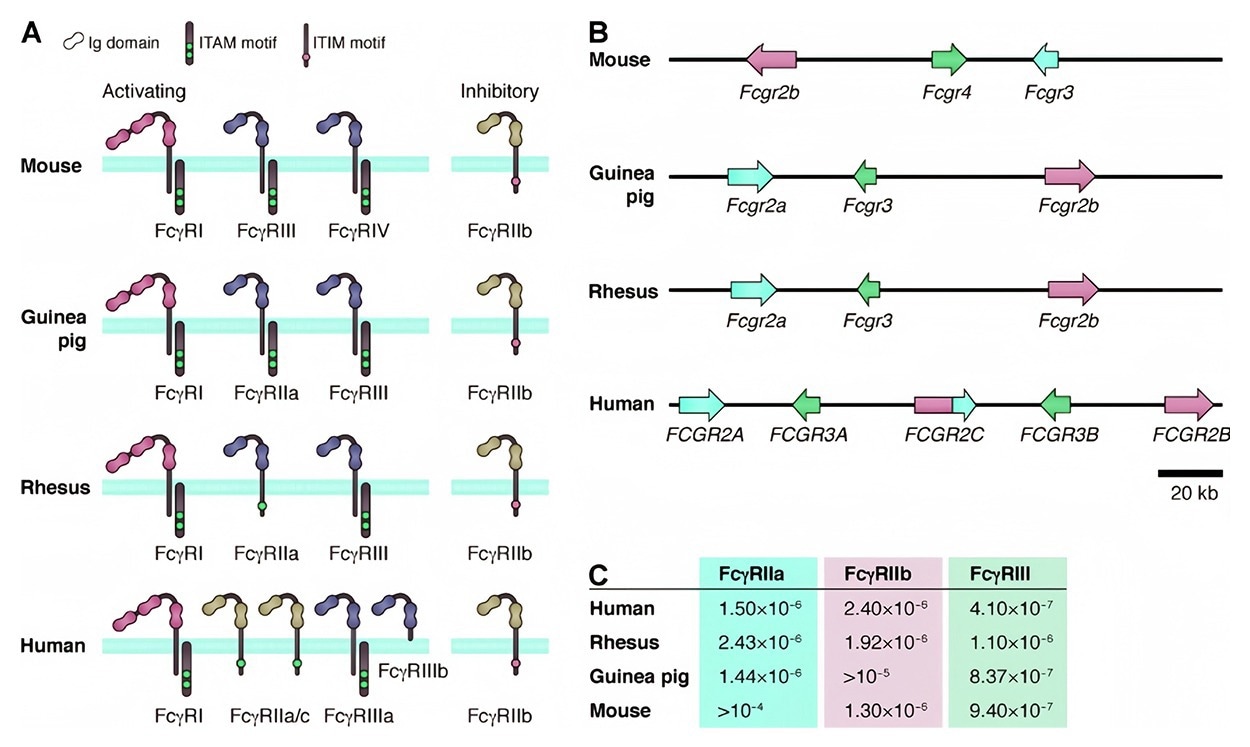
Overview of the FcR family. Image Credit: https://doi.org/10.1084/jem.20151267.
Antibody half-life assessment: FcRn affinity validation
An antibody’s half-life is a key parameter employed in the assessment of its pharmacokinetic properties. Half-life directly affects the frequency of administration and the efficacy of the drug.
One of the main factors determining therapeutic antibodies’ half-life is the interaction between the antibody’s Fc region and the neonatal Fc receptor (FcRn). FcRn is central to the body’s ability to regulate the recycling of antibodies, prolonging their half-life.1
Antibodies’ Fc fragment binds to FcRn (composed of B2M and FCGRT), especially under acidic conditions in endosomal compartments. This binding prevents the lysosomal degradation of antibodies, permitting the antibodies to be recycled back into circulation.
It is important to note, therefore, that the affinity between the Fc region of the antibody and FcRn is a determinant of the antibody’s half-life, with high affinity linked to prolonged circulation time.
An investigation into FcRn binding affinity is essential for therapeutic antibody development, offering valuable insight into the antibodies’ pharmacokinetic properties. This interaction forms the theoretical basis for predicting the pharmacokinetics and optimizing the design of antibodies with improved half-life characteristics.2
Fc-mediated effector functions (ADCC/ADCP/CDC) validation
Therapeutic antibodies exploit Fc-mediated effector functions to exert cytotoxic effects on target cells such as tumor cells. They do this via mechanisms such as Complement-Dependent Cytotoxicity (CDC), Antibody-Dependent Cellular Cytotoxicity (ADCC), and Antibody-Dependent Cellular Phagocytosis (ADCP). These mechanisms are key to monoclonal antibodies’ therapeutic efficacy, particularly in oncology.
ADCC
ADCC sees the Fab portion of the antibody binding to specific antigens on the surface of target cells, for example, tumor cells. The Fc portion also interacts with Fcγ receptors (FcγRs) on immune effector cells such as Natural Killer (NK) cells.
This interaction triggers the activation of NK cells, prompting the release of cytotoxic substances able to induce apoptosis in the target cells.3
ADCP
ADCP sees the Fc portion of the antibody binding to FcγRs on macrophages, most notably tumor-associated macrophages (TAMs). This enables the phagocytosis and subsequent target cell degradation.
This mechanism is key to cancer cell clearance while contributing to therapeutic antibodies’ overall antitumor activity.4
CDC
Complement activation through the Fc region of the antibody is also important to the immune-mediated destruction of target cells. The binding of antibodies to antigens on target cells prompts the classical complement cascade, triggering cell lysis and death.5
Good stability
Unlike the traditional LAL assay, the recombinant Factor C assay is produced using genetic engineering, ensuring minimal batch-to-batch variation and stringent quality control.
This ensures stable, reliable results between time periods and batches, offering robust support for quality control throughout the pharmaceutical manufacturing process.
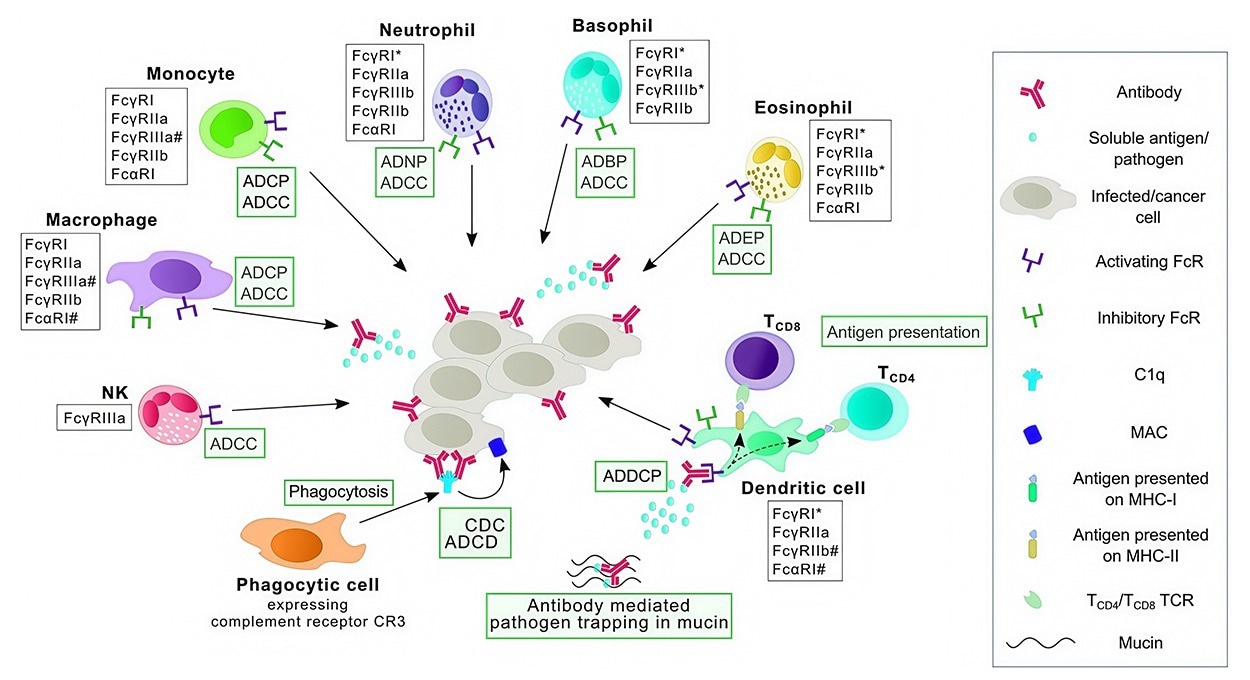
Fc-mediated effector functions: the schematic depicts the variety of cells expressing Fc receptors (FcRs) and the different types of Fc-mediated effector functions. Image Credit: https://doi.org/10.1080/19420862.2025.2453515.
Evaluating ADCC, ADCP, and CDC
The validation of ADCC, ADCP, and CDC via in vitro models represents an essential tool in screening therapeutic antibodies in preclinical stages. These models provide vital quantitative data on the antibody’s capacity to trigger immune responses, informing predictions around the clinical success of therapeutic antibody candidates.
Evaluating these functions also helps to optimize the therapeutic window and minimize off-target toxicity, ensuring improved clinical outcomes for patients.6
Summary
Antibody half-life is driven by the interaction between the Fc region and FcRn, and the assessment of this interaction represents an essential step in the development of therapeutic antibodies.
The validation of Fc-mediated effector functions, such as CDC, ADCC, and ADCP, also ensures the therapeutic efficacy of these antibodies, especially in oncology.
Each of these evaluation steps offers vital insight into antibody candidates’ pharmacokinetics and immunological activity, providing the information required to optimize their clinical development.
Incorporating these evaluations into the preclinical pipeline is imperative if therapeutic antibodies are to be effective and safe.
ACROBiosystems’ solution for half-life assessment and in vitro functional validation
ACROBiosystems has developed a series of FcRn-related products designed for the screening and validation of antibody drugs, including:
- FcRn proteins
- FcRn binding kits (TR-FRET)
- Overexpressing cell lines
A comprehensive portfolio of Fc receptor-related products is available to support Fc-mediated binding affinity studies, including:
- FcγRs, FcRn proteins
- FcR binding kits (TR-FRET)
- Overexpressing cell lines
A series of Jurkat reporter cell lines has been developed to support the determination of ADCP activity induced by antibodies, including:
- Human CD32a / CD32b Jurkat reporter cell
- Human CD64 Jurkat reporter cell
- Human CD16a Jurkat reporter cell
Product features
Source: ACROBiosystems
| . |
. |
| FcR Proteins |
- Affinity verified by SPR & BLI: Activity is guaranteed, and protocols are offered free of charge.
- High purity: SDS-PAGE verification purity>95%, SEC-MALS verification purity>90%.
- Biotinylated Fc Receptor proteins labeled with AvitagTM offered: the labeling efficiency is high, and the labeling site is specific and clear.
- Expressed by HEK293 Cells, Multiple species, High stability
|
| Binding Kits (TR-FRET) |
- Simple and fast operation: No complicated washing steps & Results in just 1 hour.
- Comprehensive validation: Validated with various antibody subtypes and antibody drugs.
- High throughput capability: Supports 500 tests, ideal for high-throughput screening.
- High batch consistency: Strict control over raw materials and finished product quality, ensuring a stable supply.
- Accurate and reliable results: High sensitivity with minimal matrix effects.
|
| Overexpressing Cell Lines |
- Genetically modified cell lines best reflect MOA (Mechanism of Action)
- Higher activity and larger assay window for robust and reproducible cell-based bioassay
- Comprehensive application data to support assay development and validation
- Full tracible record, stringent quality control and validated cell passage stability
- Parental cell line legally obtained from internationally recognized cell resource bank and commercially licensed
- Global commercial license assistance whenever regulatory filing is required
|
Assay data
FcRn proteins
FcRn high homogeneity structure verified by SEC-MALS
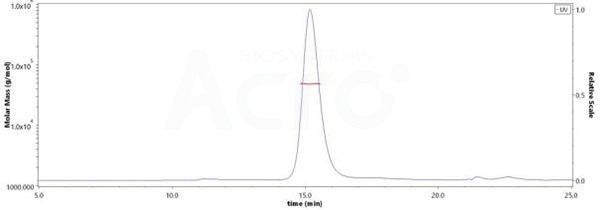
The purity of Biotinylated Canine FCGRT&B2M Heterodimer Protein, His,Avitag&Tag Free (Cat. No. FCM-C82W9) is more than 95% and the molecular weight of this protein is around 43-53 kDa verified by SEC-MALS. Image Credit: ACROBiosystems
Binding affinity of FcRn to Herceptin was validated by SPR
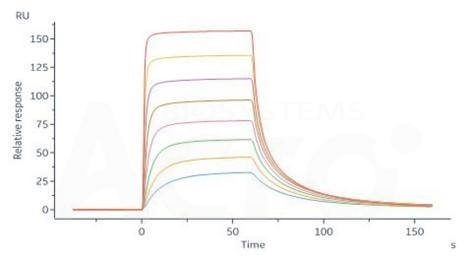
Immobilized Biotinylated Human FCGRT&B2M Heterodimer Protein, His,Avitag (Cat. No. FCM-H82W7) on SA Chip can bind Herceptin® with an affinity constant of 0.267 μM as determined in a SPR assay (Biacore 8K) (QC tested). Image Credit: ACROBiosystems
FcRn binding kit (TR-FRET)
Application of antibody drug half-life assessment
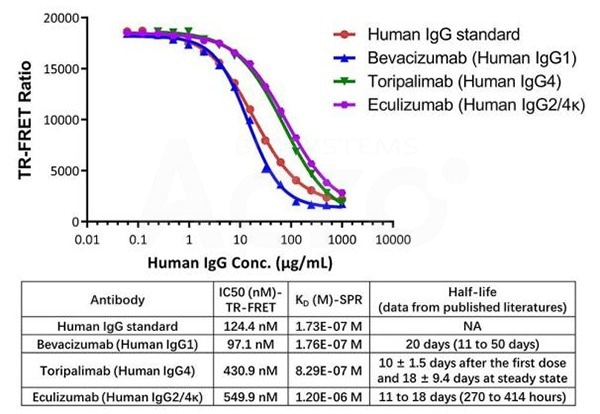
The half-lives of these 3 monoclonal antibodies currently in clinical use generally correlate with the binding affinity to FcRn. The kit has been used to detect 3 FDA-approved antibody drugs of different binding affinity to FcRn, and the IC50 trends are consistent with the affinity constant from SPR, as well as the actual in vivo half-life published. Image Credit: ACROBiosystems
FcRn overexpressing cell lines
Receptor assay
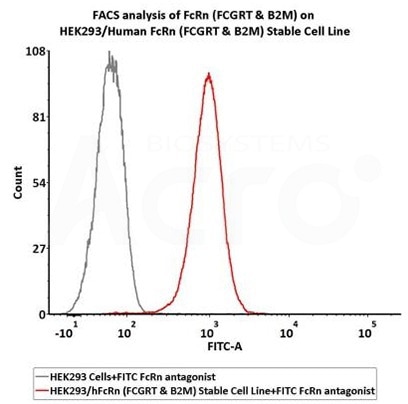
FACS analysis of FcRn (FCGRT & B2M) on HEK293/Human FcRn (FCGRT & B2M) Stable Cell Line. FACS assay shows that FITC-Labeled Human IgG1 Fc (C103S, M135Y, S137T, T139E, H316K, N317F) Protein, His Tag (Cat. No. IG1-HF2H3) can bind to HEK293/Human FcRn (FCGRT & B2M) Stable Cell Line. HEK293/Human FcRn (FCGRT & B2M) Stable Cell Line was red line, negative control HEK293 cells was grey line (QC tested). Image Credit: ACROBiosystems
References and further reading
- Roopenian, D.C. and Akilesh, S. (2007). FcRn: the neonatal Fc receptor comes of age. Nature Reviews. Immunology, (online) 7(9), pp.715–725. https://doi.org/10.1038/nri2155.
- Shire, S. J., et al. (2006). Development of Therapeutic Monoclonal Antibodies. Pharmaceutical Research, 23(10), 2121-2136.
- Msaouel P, et al. Fc-Mediated Effector Functions in Therapeutic Monoclonal Antibodies. J Immunol. 2015;194(10):4862-4871.
- Weiner, G. J. (2015). Monoclonal Antibodies in Cancer Therapy: Advances and Challenges. Nat Rev Cancer, 15, 87–100. doi:10.1038/nrc3803.
- Nimmerjahn, F. and Ravetch, J.V. (2008). Fcγ receptors as regulators of immune responses. Nature Reviews Immunology, (online) 8(1), pp.34–47. https://doi.org/10.1038/nri2206.
- Shi, J., et al. (2018). Recent advances in antibody-drug conjugates for cancer therapy. J Hematol Oncol, 11, 44.
- Crescioli, S., Jatiani, S. and Moise, L. (2025). With great power, comes great responsibility: the importance of broadly measuring Fc-mediated effector function early in the antibody development process. mAbs, 17(1). https://doi.org/10.1080/19420862.2025.2453515.
Acknowledgments
Produced from materials originally authored by ACROBiosystems.
About ACROBiosystems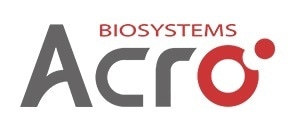
ACROBiosystems is a cornerstone enterprise of the pharmaceutical and biotechnology industries. Their mission is to help overcome challenges with innovative tools and solutions from discovery to the clinic. They supply life science tools designed to be used in discovery research and scalable to the clinical phase and beyond. By consistently adapting to new regulatory challenges and guidelines, ACROBiosystems delivers solutions, whether it comes through recombinant proteins, antibodies, assay kits, GMP-grade reagents, or custom services. ACROBiosystems empower scientists and engineers dedicated towards innovation to simplify and accelerate the development of new, better, and more affordable medicine.
Sponsored Content Policy: News-Medical.net publishes articles and related content that may be derived from sources where we have existing commercial relationships, provided such content adds value to the core editorial ethos of News-Medical.Net which is to educate and inform site visitors interested in medical research, science, medical devices and treatments.